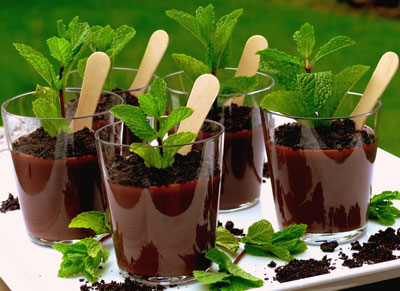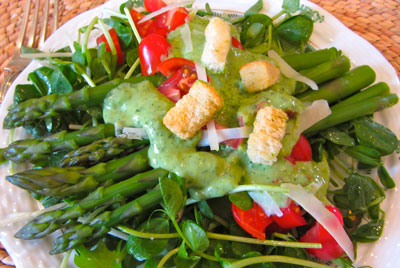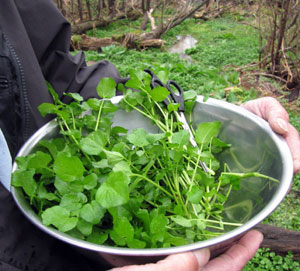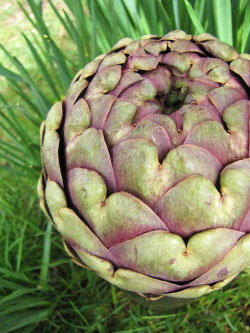Before they disappear, run out and get those early season asparagus and fresh garlic bulbs and make this dish or the kitchen gods will be angry. This is a very versatile soup – it can be eaten, hot, lukewarm and cold. Unlike 99.99% of asparagus soups served in restaurants especially those in Paris, this soup has no cream. But it does have a secret fatty ingredient.
1.5 pounds asparagus – chopped
Reserve tips of 3 asparagus and mince very finely
4 cloves fresh spring garlic – garlic greens are also good (for a nice switcheroo substitute baby or spring ginger which is just coming into season – about a 1/2 inch piece chopped)
1/2 cup raw pumpkin seeds
3 cups chicken or vegetable stock
1/4 cup sake or dry white wine like a sauvignon blanc
Salt and ground black pepper to taste
Couple of pinches of coriander powder
1. Heat stock for 2 minutes; add all the ingredients except the minced asparagus tips and coriander. Heat under medium heat (covered) for 10 minutes.
2. Pour contents in a blender (if you have a Vitamix there is no need to strain it, but you may want to strain it to remove any woody asparagus pulp if you have a regular blender) for 3 minutes until completely smooth.
3. Pour contents back in pot under low heat for 10 minutes, add coriander powder and adjust salt.
4. Serve in bowls and garnish with minced asparagus.
 These mini mint puddings sprout to life with their mint seedling growing out the top and ground-cookie dirt sprinkled on the surface.
These mini mint puddings sprout to life with their mint seedling growing out the top and ground-cookie dirt sprinkled on the surface.
 Of all the spring vegetables, asparagus is one of the easiest to prepare…simply grilled, oven roasted or shredded raw as a salad, it needs little more than salt and lemon to qualify as a side dish. But if you’re looking to dress up those slender stalks in a more elegant way, try this: Cold Poached Asparagus with Skinny Basil Mayonnaise.
Of all the spring vegetables, asparagus is one of the easiest to prepare…simply grilled, oven roasted or shredded raw as a salad, it needs little more than salt and lemon to qualify as a side dish. But if you’re looking to dress up those slender stalks in a more elegant way, try this: Cold Poached Asparagus with Skinny Basil Mayonnaise. Sneaking around is so much fun. Like heisting those leeks a few weeks ago, we had the best time on Friday clandestinely gathering wild watercress from a fresh-water stream deep in the woods. Scissors in hand, we scurried down a path of pine needles, all the while looking over our shoulders, hoping no one would see us through the mist and fog and tangled brush.
Sneaking around is so much fun. Like heisting those leeks a few weeks ago, we had the best time on Friday clandestinely gathering wild watercress from a fresh-water stream deep in the woods. Scissors in hand, we scurried down a path of pine needles, all the while looking over our shoulders, hoping no one would see us through the mist and fog and tangled brush. Well, I am embarrassed to admit that I got overwhelmed in Whole Foods the other day. Here I am a Food Professional (whatever that is), and the sheer abundance of goodies in the store was just too much for me. Granted, it was a quick stop—I only had 10 minutes to troll the store, as I was on my way to a book signing at
Well, I am embarrassed to admit that I got overwhelmed in Whole Foods the other day. Here I am a Food Professional (whatever that is), and the sheer abundance of goodies in the store was just too much for me. Granted, it was a quick stop—I only had 10 minutes to troll the store, as I was on my way to a book signing at 
